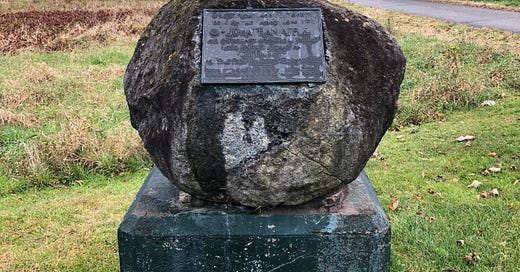On a perfectly nondescript road in a perfectly nondescript town I came across the origin of one of the most perfectly nondescript apples. And to my great joy, the origin of the Jonathan Apple was memorialized on a stone!
The stone, in Woodstock, NY, reads in part: On a ridge 400 feet south originated about 1800 the Johnathan Apple. There’s nothing to warn you. There’s no parking. It’s just sitting there next to the road, so I pulled over.
Way back when Thomas Jefferson himself was planting apple trees at Monticello, one of his favorite varieties was the Spitzenburg variety, discovered in the early part of the 18th century in nearby Esopus, NY. The Spitzenburg is the primary apple for baking and cider. Herman Melville himself mentioned it in Bartleby the Scrivener.
Then around 1826, up there on the ridge in front of me, farmer Phillip Rick cultivated a new apple out of the Spitzenburg. Originally named The Rickey, the apple was a little larger and good for eating fresh with a tougher outer skin.
Well, poor farmer Rick got the short end of the history stick after a fellow by the name of Jonathan Zander brought the apple back to Judge Jesse Buel, President of Albany Horticultural Society. Judge Buel named it the Jonathan and the rest is history.
Or at least is history according to a granite rock along side a lonely road in upstate New York.
Housekeeping: Speaking of Memorial Stones, the second volume in our Rocks That Rock series - a field guide to NH Memorial Stones - is about to head to the printer so we’ll have it in time for the holidays. You can learn more about the book here: More NH Rocks That Rock.
Thanks for following along on our November daily journey. No promises that I’ll be able to post every day, but so far so good. And remember, you’re shares and reposts help us a lot!
Keep on keeping on!





Stormalong Cider in central mass I believe does a spitzenburg